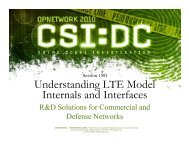Understanding TCP/IP Model Internals and Interfaces
Understanding TCP/IP Model Internals and Interfaces
Understanding TCP/IP Model Internals and Interfaces
Create successful ePaper yourself
Turn your PDF publications into a flip-book with our unique Google optimized e-Paper software.
1508 <strong>Underst<strong>and</strong>ing</strong> <strong>TCP</strong>/<strong>IP</strong> <strong>Model</strong> <strong>Internals</strong> <strong>and</strong> <strong>Interfaces</strong><br />
Initialization: Address Assignment<br />
Each MAC process in the network must have a unique integer address. This address may be<br />
manually assigned via an attribute or programmatically generated. The simple_mac process uses the<br />
OPNET auto-addressing package called oms_aa to assign addresses. This package is capable of<br />
assigning unique integer addresses to all or some of the nodes in the network. More information<br />
about this package is available in the session material of 1528–Accelerating <strong>Model</strong> Development<br />
with OPNET’s <strong>Model</strong> Support Libraries. The address must be assigned before proceeding to the<br />
next step (process registry).<br />
Initialization: Process Registry<br />
In this step, the MAC process must publish its address in the model-wide process registry so that the<br />
ARP module in each node can learn the MAC address. This information is later used to translate <strong>IP</strong><br />
addresses to MAC addresses.<br />
CONFIDENTIAL – RESTRICTED ACCESS: This information may not be disclosed, copied, or transmitted in any format without the prior written consent of OPNET Technologies, Inc.<br />
© 2010 OPNET Technologies, Inc.<br />
32
















